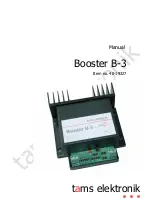
Instruction Manual
3
5. Connect the UTP cable connection from the Local unit to the RJ45 connector on the
Remote unit. If using premises cabling, connect the opposite end of the patch cable
to the terminated wall outlet.
6. Connect the power adapters to the Local and Remote units. Each unit uses a
specific power adapter (5VDC for Local, 24VDC for Remote), so ensure the correct
power adapter is connected, otherwise damage may occur.
7. The “Status” LED should light up on both units to indicate power. The “Link” LED should
also light up to indicate a connection between the Local and Remote units is established.
Note: It may take up to one minute for the system to boot up.
How to Use
Audio
The audio component of the extender uses a built-in USB Audio Device to transmit
audio from the Host computer to the Remote unit. The Host computer system should
detect and automatically install the audio adapter once the USB cable is connected,
usually setting it as the default audio adapter for the system. Check in the Audio
Properties of the operating system (i.e. “Sound and Audio Devices” in Control Panel for
Windows XP or “Sound” in System Preferences for Mac OS X) to verify the installation
and status of the USB audio adapter. If the audio component of the extender will not
be used, then you may wish to set the default audio device back to the onboard audio.






























